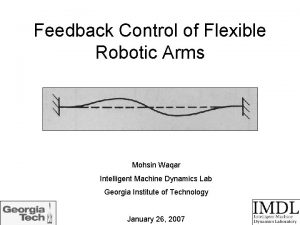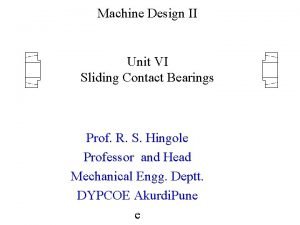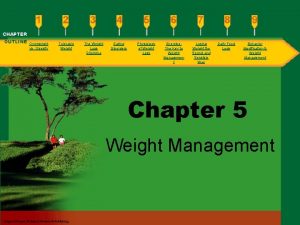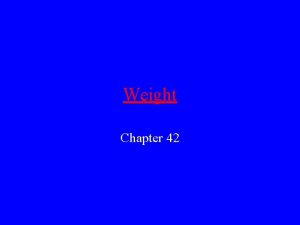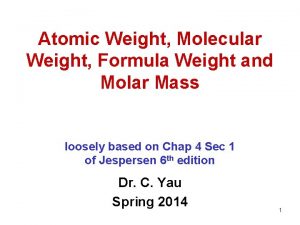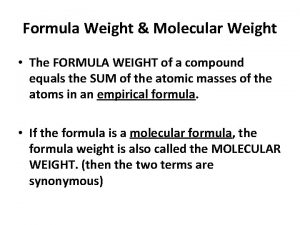ESTIMATING WEIGHT Mirza Muhammad Waqar Contact mirza waqarist





















- Slides: 21

ESTIMATING WEIGHT Mirza Muhammad Waqar Contact: mirza. waqar@ist. edu. pk +92‐ 21‐ 34650765‐ 79 EXT: 2257 RG 712 Course: Special Topics in Remote Sensing & GIS

Estimating Weights A weight can be defined as a value assigned to an evaluation criterion that indicates its importance relative to other criteria under consideration. The larger the weight, the more important is the criterion in the overall utility. Assigning weights of importance to evaluation criteria accounts for: 1. 2. Changes in the range of variation for each evaluation criterion The different degrees of importance being attached to these ranges of variation.

Ranking Method The simplest method for assessing the importance of weights is to arrange them in rank order in the order of the decision maker’s preference. Straight ranking 1 most important , 2, 3…n least important Inverse ranking 1: least important, 2, 3…n most important Once the ranking established for a set of criteria, generate numerical weights from rank‐order information

Ranking Method P = 0 results in equal weights to all the criteria P = 1 results in rank sum weight

Site Selection using Ranking Method

Rating Method The rating methods require the decision maker to estimate weights on the basis of a predetermined scale. i. e. 0 to 100 0 indicted that the criterion can be ignored 100 means only one criterion need to be considered.

1. Point Allocation Method 50 points to the cost of establishing the plant. (W: 0. 5) 30 points to accessibility to the transportation. (W: 0. 3) 20 points to the availability of water. (W: 0. 2) Sum= 0 (ignore) location Sum=100 Select with confidence

2. Ratio Estimation Procedure It starts by assigning an arbitrary weight to the most important criterion, as identified by one of the ranking methods. A score of 100 is assigned to the most important criterion. Proportionately smaller wrights are then given to criteria lower in the order. The procedure is continued until a score is assigned to the least important criterion which shall then be taken as an anchor point for calculating the ratios. Score of each criterion is divided by the score of the least important criterion Wj/W* where Wj is the score for the jth criterion and W* is lowest score.

Site Selection using Rating Method

Pair‐wise Comparison Methods Developed by Saatay (1980) in the context of AHP (Analytic Hierarchy Process) This method involves pair‐wise comparisons to create a ratio matrix. It takes pair‐wise comparisons as input and produces the relative weights as output. 1. 2. 3. Development of the pair‐wise comparison matrix Computation of the criterion weights Estimation of the consistency ratio

Scale for Pair‐wise Comparison

Example: Site Suitability Analysis Parameters: 1. 2. 3. Price Slope View Price is moderately to strongly preferred over slope Price is very strongly preferred over view Slope is strongly preferred over view

Step 1: Development of Pairwise Comparison Matrix

Step 2: Computation of the Criterion Weights This step involves following operations: 1. 2. 3. Sum the values in each column of the pair‐wise comparison matrix. Divide each element in the matrix by its column total Compute the average of elements in each row of the normalized matrix.

Step 2: Computation of the Criterion Weights

Step 3: Estimation of the Consistency Ratio This step involves following operations: Determine the weighted sum vector by multiplying the criterion weights with the values of the original pairwise comparison matrix and finally sum these values over rows. Determine the consistency vector by dividing the weighted sum vector by the criterion weights.

Step 3: Estimation of the Consistency Ratio

Step 3: Estimation of the Consistency ratio Computation of Lambda λ : λ = (3. 250+3. 119+3. 014) / 3 = 3. 128 λ should always be greater than or equal to the number of criterion to be considered. λ = n (if the pair wise comparison matrix is a consistent matrix)

Step 3: Estimation of the Consistency ratio Computation of CI (Consistency Index) : CI= (λ‐n) / (n‐ 1) = (3. 128‐ 3) / (3‐ 1) = 0. 064 Computation of CR (Consistency Ratio) : CR= CI / RI = 0. 064 / 0. 58 = 0. 110 Where RI is the random index provided by Saaty and it depends on the number of criterion (n).

Random Inconsistency Index RI If CR<0. 10 the ratio indicates a reasonable level of consistency. If CR>0. 10 the ratio indicates an inconsistent judgment and the relative criterion pair wise comparison matrix needs reconsideration and the whole process must be repeated.

Questions & Discussion
 Dr waqar malik
Dr waqar malik Samina waqar
Samina waqar Dr mohsin waqar
Dr mohsin waqar Saiama waqar
Saiama waqar Wa ta izzu man tasha meaning in urdu
Wa ta izzu man tasha meaning in urdu Attahiyat lillahi wa salawatu
Attahiyat lillahi wa salawatu Which force
Which force Irritant vs contact dermatitis
Irritant vs contact dermatitis Contact and non contact forces
Contact and non contact forces What are some contact forces and some noncontact forces?
What are some contact forces and some noncontact forces? Which of the following is sliding contact bearing
Which of the following is sliding contact bearing Air resistance is a non contact force
Air resistance is a non contact force Contact vs non contact forces
Contact vs non contact forces Shottky contact
Shottky contact Contact vs field forces
Contact vs field forces Post encounter stage in service marketing
Post encounter stage in service marketing Tolerable weight is a body weight
Tolerable weight is a body weight Is aluminum bulk gaining or reducing
Is aluminum bulk gaining or reducing Donovan delaney
Donovan delaney Model bayesian
Model bayesian Mirza zen
Mirza zen Mirza salman baig
Mirza salman baig


